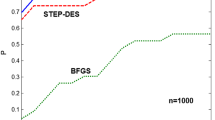Abstract
The properties of multilevel optimization problems defined on a hierarchy of discretization grids can be used to define approximate secant equations, which describe the second-order behavior of the objective function. Following earlier work by Gratton and Toint (2009) we introduce a quasi-Newton method (with a linesearch) and a nonlinear conjugate gradient method that both take advantage of this new second-order information. We then present numerical experiments with these methods and formulate recommendations for their practical use.
Similar content being viewed by others
References
Briggs, W.L., Henson, V.E., McCormick, S.F.: A Multigrid Tutorial, 2nd edn. SIAM, Philadelphia (2000)
Broyden, C.G.: The convergence of a class of double-rank minimization algorithms. J. Inst. Math. Appl. 6, 76–90 (1970)
Dai, Y., Yuan, Y.: An efficient hybrid conjugate gradient method for unconstrained optimization. Ann. Oper. Res. 103, 33–47 (2001)
Dai, Y.H., Yuan, Y.: A nonlinear conjugate gradient method with a strong global convergence property. SIAM J. Optim. 10(1), 177–182 (1999)
Dennis, J.E., Schnabel, R.B.: Numerical Methods for Unconstrained Optimization and Nonlinear Equations. Prentice Hall, Englewood Cliffs (1983). Reprinted as Classics in Applied Mathematics, vol. 16, SIAM, Philadelphia (1996)
Dolan, E.D., Moré, J.J.: Benchmarking optimization software with performance profiles. Math. Program. 91(2), 201–213 (2002)
Fisher, M.: Minimization algorithms for variational data assimilation. In: Recent Developments in Numerical Methods for Atmospheric Modelling, pp. 364–385 (1998). ECMWF
Fletcher, R.: A new approach to variable metric algorithms. Comput. J. 13, 317–322 (1970)
Fletcher, R., Reeves, C.M.: Function minimization by conjugate gradients. Comput. J. 7, 149–154 (1964)
Goldfarb, D.: A family of variable metric methods derived by variational means. Math. Comput. 24, 23–26 (1970)
Gratton, S., Malmedy, V., Toint, Ph.L.: Using approximate secant equations in limited memory methods for multilevel unconstrained optimization. Tech. rep. 2009/18, Department of Mathematics, University of Namur, Namur, Belgium (2009)
Gratton, S., Mouffe, M., Sartenaer, A., Toint, Ph.L., Tomanos, D.: Numerical experience with a recursive trust-region method for multilevel nonlinear optimization. Optim. Methods Softw. 25(3), 359–386 (2010)
Gratton, S., Mouffe, M., Toint, Ph.L., Weber-Mendonça, M.: A recursive trust-region method in infinity norm for bound-constrained nonlinear optimization. IMA J. Numer. Anal. 28(4), 827–861 (2008)
Gratton, S., Sartenaer, A., Toint, Ph.L.: Recursive trust-region methods for multiscale nonlinear optimization. SIAM J. Optim. 19(1), 414–444 (2008)
Gratton, S., Toint, Ph.L.: Approximate invariant subspaces and quasi-Newton optimization methods. Optim. Methods Softw. 25(4), 507–529 (2010)
Hager, W.W., Zhang, H.: A new conjugate gradient method with guaranteed descent and an efficient line search. SIAM J. Optim. 16(1), 170–192 (2005)
Hager, W.W., Zhang, H.: Algorithm 851: CG_DESCENT, a conjugate gradient method with guaranteed descent. ACM Trans. Math. Softw. 32(1), 113–137 (2006)
Hager, W.W., Zhang, H.: A survey of nonlinear conjugate gradient methods. Pac. J. Optim. 2, 35–58 (2006)
Hestenes, M.R., Stiefel, E.: Methods of conjugate gradients for solving linear systems. J. Res. Natl. Bur. Stand. 49(6), 409–436 (1952)
Liu, D.C., Nocedal, J.: On the limited memory BFGS method for large scale optimization. Math. Program. Ser. B 45(1), 503–528 (1989)
Nash, S.G.: A multigrid approach to discretized optimization problems. Optim. Methods Softw. 14, 99–116 (2000)
Nocedal, J.: Updating quasi-Newton matrices with limited storage. Math. Comput. 35, 773–782 (1980)
Oh, S., Milstein, A., Bouman, C., Webb, K.: Multigrid algorithms for optimization and inverse problems. In: Bouman, C., Stevenson, R. (eds.) Computational Imaging. Proceedings of the SPIE, vol. 5016, pp. 59–70 (2003). DDM
Shanno, D.F.: Conditioning of quasi-Newton methods for function minimization. Math. Comput. 24, 647–657 (1970)
Author information
Authors and Affiliations
Corresponding author
Rights and permissions
About this article
Cite this article
Gratton, S., Malmedy, V. & Toint, P.L. Using approximate secant equations in limited memory methods for multilevel unconstrained optimization. Comput Optim Appl 51, 967–979 (2012). https://doi.org/10.1007/s10589-011-9393-3
Received:
Published:
Issue Date:
DOI: https://doi.org/10.1007/s10589-011-9393-3




